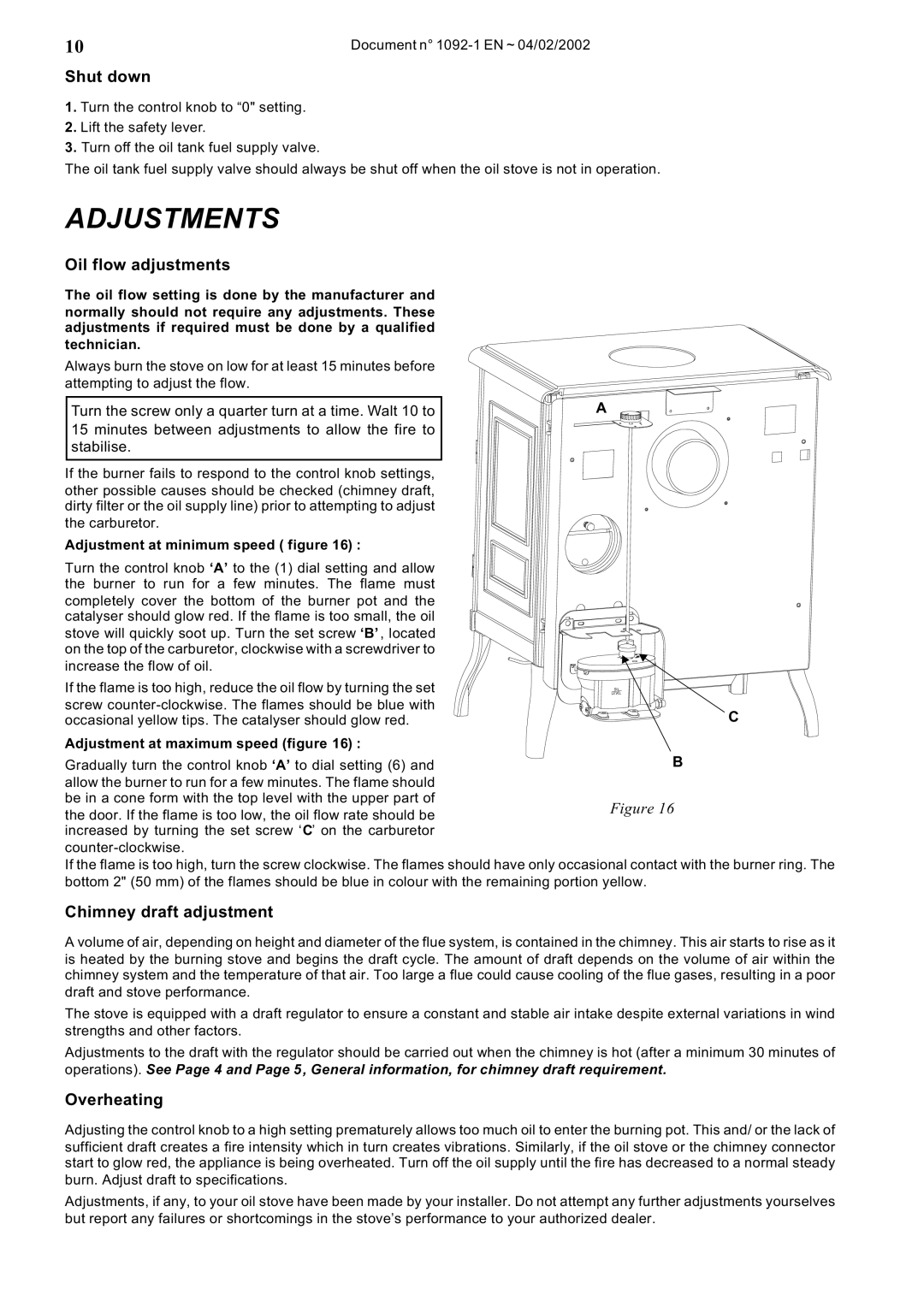
10 | Document n° |
Shut down
1.Turn the control knob to “0" setting.
2.Lift the safety lever.
3.Turn off the oil tank fuel supply valve.
The oil tank fuel supply valve should always be shut off when the oil stove is not in operation.
ADJUSTMENTS
Oil flow adjustments
The oil flow setting is done by the manufacturer and normally should not require any adjustments. These adjustments if required must be done by a qualified technician.
Always burn the stove on low for at least 15 minutes before attempting to adjust the flow.
Turn the screw only a quarter turn at a time. Walt 10 to 15 minutes between adjustments to allow the fire to stabilise.
If the burner fails to respond to the control knob settings, other possible causes should be checked (chimney draft, dirty filter or the oil supply line) prior to attempting to adjust the carburetor.
A
Adjustment at minimum speed ( figure 16) : |
| |
Turn the control knob ‘A’ to the (1) dial setting and allow |
| |
the burner to run for a few minutes. The flame must |
| |
completely cover the bottom of the burner pot and the |
| |
catalyser should glow red. If the flame is too small, the oil |
| |
stove will quickly soot up. Turn the set screw ‘B’ , located |
| |
on the top of the carburetor, clockwise with a screwdriver to |
| |
increase the flow of oil. |
| |
If the flame is too high, reduce the oil flow by turning the set |
| |
screw | C | |
occasional yellow tips. The catalyser should glow red. | ||
Adjustment at maximum speed (figure 16) : |
| |
Gradually turn the control knob ‘A’ to dial setting (6) and | B | |
allow the burner to run for a few minutes. The flame should |
| |
be in a cone form with the top level with the upper part of | Figure 16 | |
the door. If the flame is too low, the oil flow rate should be | ||
| ||
increased by turning the set screw ‘C’ on the carburetor |
|
If the flame is too high, turn the screw clockwise. The flames should have only occasional contact with the burner ring. The bottom 2" (50 mm) of the flames should be blue in colour with the remaining portion yellow.
Chimney draft adjustment
A volume of air, depending on height and diameter of the flue system, is contained in the chimney. This air starts to rise as it is heated by the burning stove and begins the draft cycle. The amount of draft depends on the volume of air within the chimney system and the temperature of that air. Too large a flue could cause cooling of the flue gases, resulting in a poor draft and stove performance.
The stove is equipped with a draft regulator to ensure a constant and stable air intake despite external variations in wind strengths and other factors.
Adjustments to the draft with the regulator should be carried out when the chimney is hot (after a minimum 30 minutes of operations). See Page 4 and Page 5 , General information, for chimney draft requirement.
Overheating
Adjusting the control knob to a high setting prematurely allows too much oil to enter the burning pot. This and/ or the lack of sufficient draft creates a fire intensity which in turn creates vibrations. Similarly, if the oil stove or the chimney connector start to glow red, the appliance is being overheated. Turn off the oil supply until the fire has decreased to a normal steady burn. Adjust draft to specifications.
Adjustments, if any, to your oil stove have been made by your installer. Do not attempt any further adjustments yourselves but report any failures or shortcomings in the stove’s performance to your authorized dealer.
